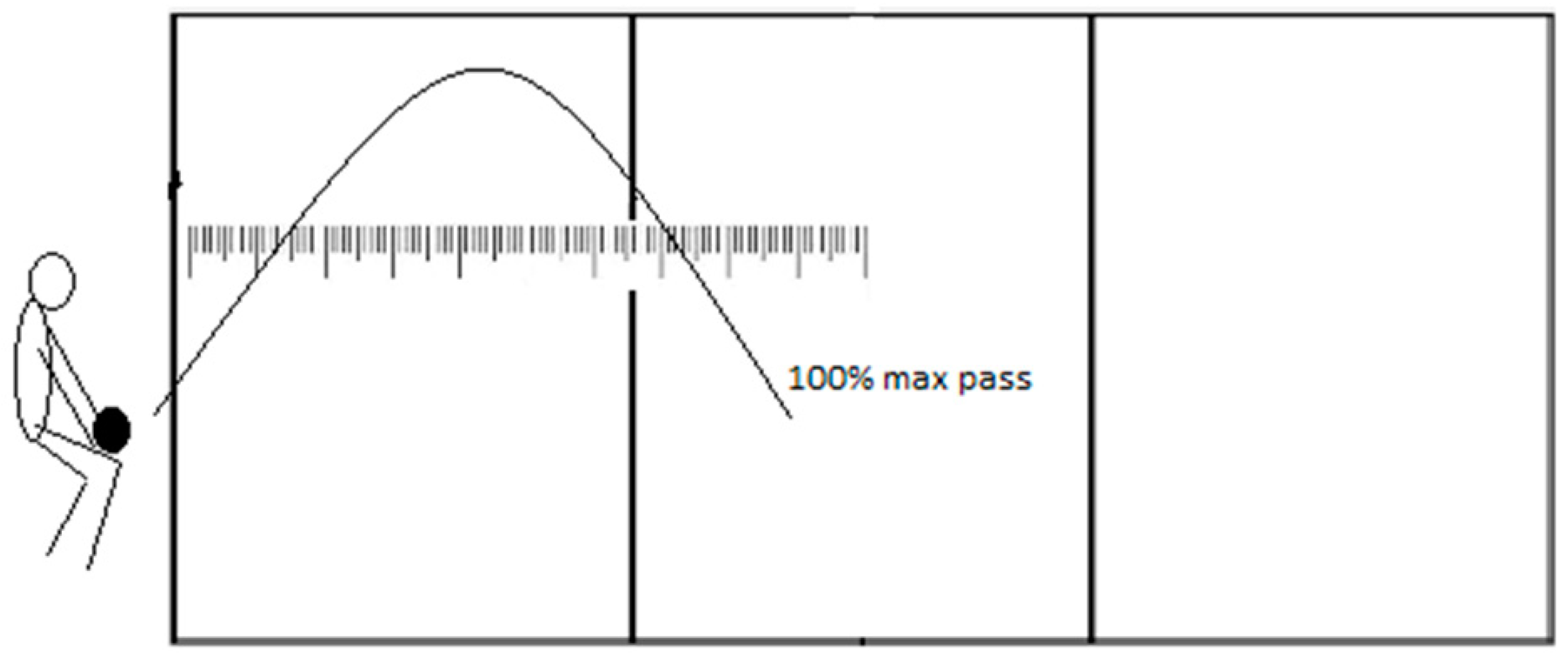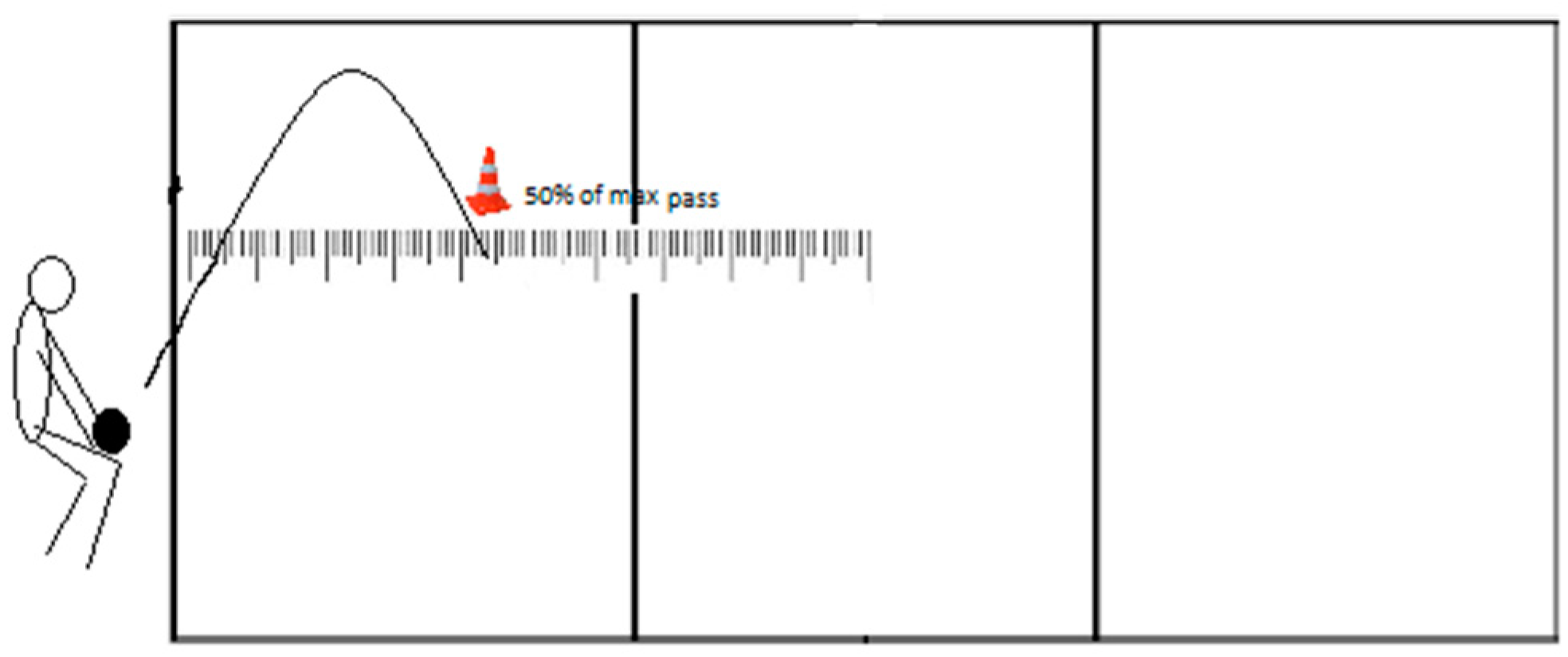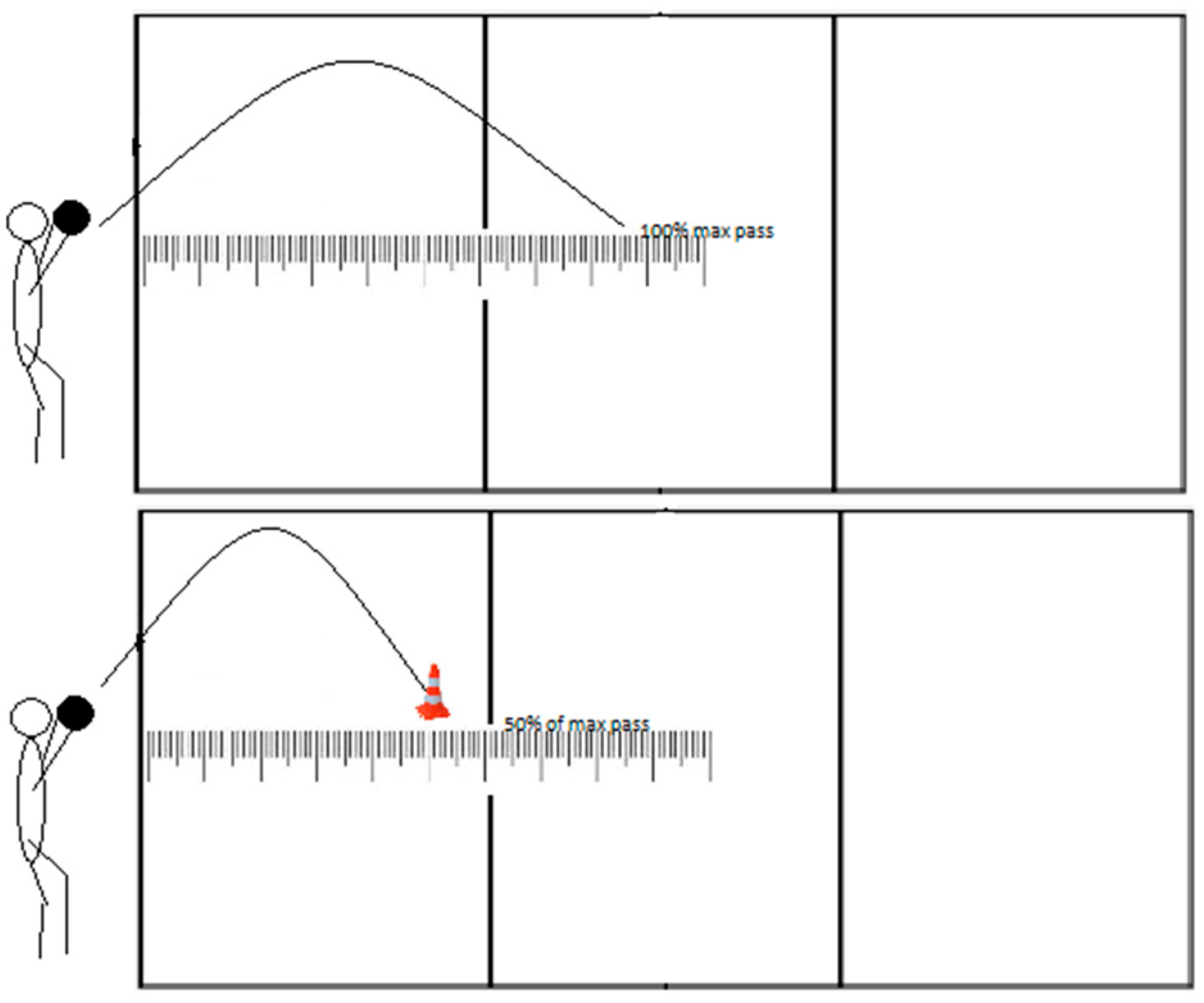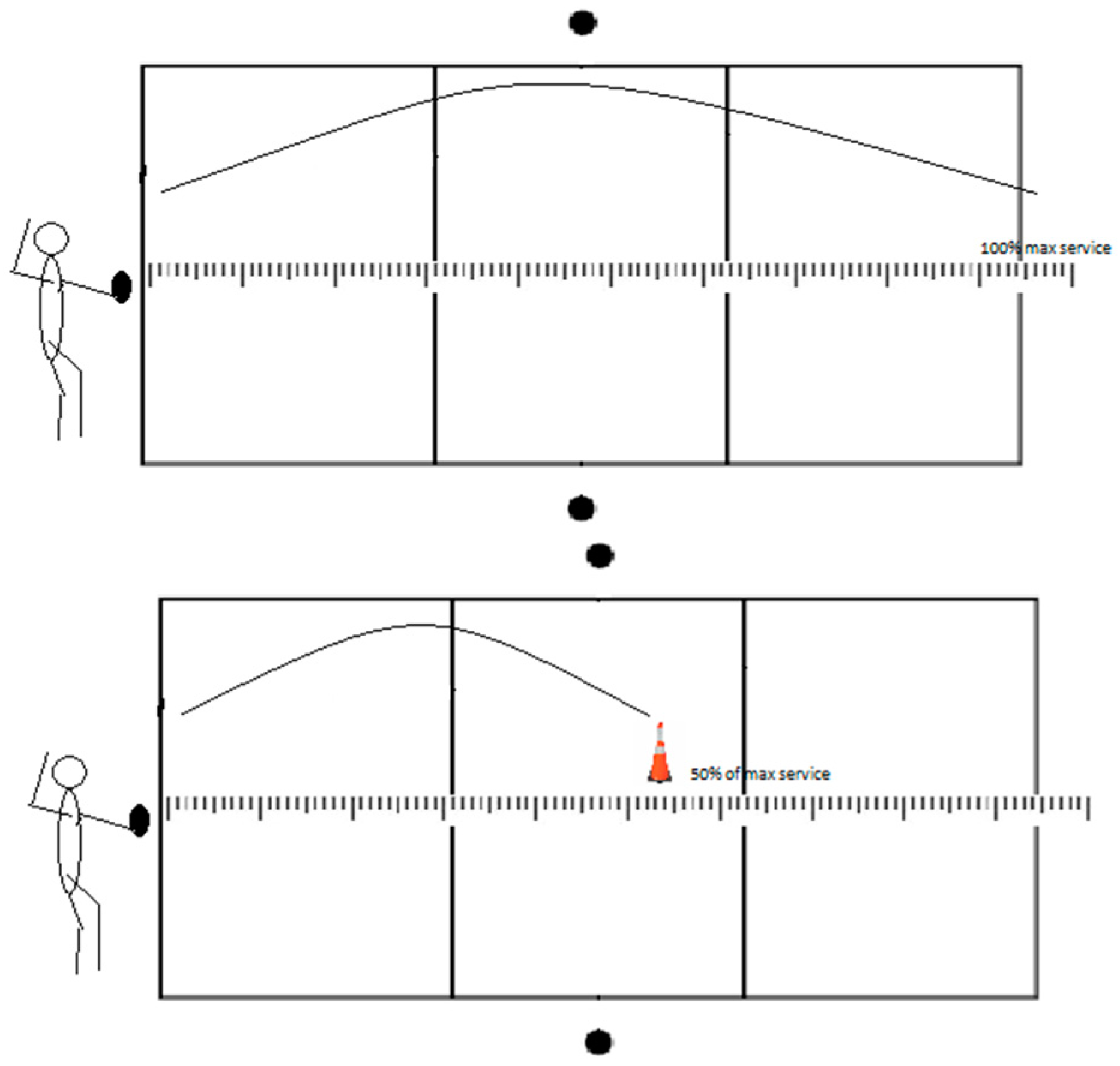New Specific Kinesthetic Differentiation Tests for Female Volleyball Players: Reliability, Discriminative Ability, and Usefulness
Abstract
1. Introduction
2. Materials and Methods
2.1. Study Design
2.2. Participants
2.3. Experimental Procedures
2.3.1. Forearm Passing Test (FPT)
2.3.2. Overhead Pass Test (OPT)
2.3.3. Float Service Tests (FST)
2.4. Statistical Analysis
3. Results
4. Discussion
5. Conclusions
Author Contributions
Funding
Institutional Review Board Statement
Informed Consent Statement
Data Availability Statement
Acknowledgments
Conflicts of Interest
References
- Grgantov, Z.; Katić, R.; Janković, V. Morphological Characteristics, Technical and Situation Efficacy of Young Female Volleyball Players. Coll. Antropol. 2006, 30, 87–96. [Google Scholar] [PubMed]
- Milić, M.; Grgantov, Z.; Chamari, K.; Ardigò, L.P.; Bianco, A.; Padulo, J. Anthropometric and Physical Characteristics Allow Differentiation of Young Female Volleyball Players According to Playing Position and Level of Expertise. Biol. Sport 2017, 34, 19–26. [Google Scholar] [CrossRef]
- Sheppard, J.M.; Cronin, J.B.; Gabbett, T.J.; Mcguigan, M.R.; Etxebarria, N.; Newton, R.U. Relative Importance of Strength, Power, and Anthropometric Measures to Jump Performance of Elite Volleyball Players. J. Strength Cond. Res. 2008, 22, 758–765. [Google Scholar] [CrossRef] [PubMed]
- Boichuk, R.; Iermakov, S.; Kovtsun, V.; Pasichnyk, V.; Melnyk, V.; Lazarenko, M.; Kovtsun, V. Effect of Physical Development Parameters and Conditioning Abilities on the Level of Motor Coordination in Female Volleyball Players in the Phase of Specialized Basic Training. J. Phys. Educ. Sport 2018, 18, 1950–1957. [Google Scholar]
- Šimonek, J. The Effect of Intervention on the Changes of Coordination Factors in the Youth Sports Preparation. Sport Sci. 2016, 9, 77–81. [Google Scholar]
- Ford, P.; de Ste Croix, M.; Lloyd, R.; Meyers, R.; Moosavi, M.; Oliver, J.; Till, K.; Williams, C. The Long-Term Athlete Development Model: Physiological Evidence and Application. J. Sports Sci. 2011, 29, 389–402. [Google Scholar] [CrossRef] [PubMed]
- Hirtz, P.; Starosta, W. Sensitive and Critical Periods of Motor Co-Ordination Development and Its Relation to Motor Learning. J. Hum. Kinet. 2002, 7, 19–28. [Google Scholar]
- Viru, A.; Loko, J.; Harro, M.; Volver, A.; Laaneots, L.; Viru, M. Critical Periods in the Development of Performance Capacity During Childhood and Adolescence. Eur. J. Phys. Educ. 1999, 4, 75–119. [Google Scholar] [CrossRef]
- Van Hooren, B.; De Ste Croix, M. Sensitive Periods to Train General Motor Abilities in Children and Adolescents: Do They Exist? A Critical Appraisal. Strength Cond. J. 2020, 42, 7–14. [Google Scholar] [CrossRef]
- Quatman-Yates, C.C.; Quatman, C.E.; Meszaros, A.J.; Paterno, M.V.; Hewett, T.E. A Systematic Review of Sensorimotor Function during Adolescence: A Developmental Stage of Increased Motor Awkwardness? Br. J. Sports Med. 2012, 46, 649–655. [Google Scholar] [CrossRef]
- Lech, G.; Jaworski, J.; Lyakh, V.; Krawczyk, R. Effect of the Level of Coordinated Motor Abilities on Performance in Junior Judokas. J. Hum. Kinet. 2011, 30, 153–160. [Google Scholar] [CrossRef] [PubMed]
- Malikova, A.N.; Doroshenko, E.Y.; Symonik, A.V.; Tsarenko, E.V.; Veritov, A.I. The Ways of Improvement Special Physical Training of High-Qualified Women Volleyball Players in Competitive Period of Annual Macrocycle. Phys. Educ. Stud. 2018, 22, 38. [Google Scholar] [CrossRef]
- Kamandulis, S.; Venckunas, T.; Masiulis, N.; Matulaitis, K.; Balčiunas, M.; Peters, D.; Skurvydas, A. Relationship between General and Specific Coordination in 8- to 17-Year-Old Male Basketball Players. Percept. Mot. Ski. 2013, 117, 821–836. [Google Scholar] [CrossRef]
- Trecroci, A.; Cavaggioni, L.; Caccia, R.; Alberti, G. Jump Rope Training: Balance and Motor Coordination in Preadolescent Soccer Players. J. Sports Sci. Med. 2015, 14, 792–798. [Google Scholar] [PubMed]
- Šimonek, J. Coordination Abilities in Volleyball; De Gruyter Open: Warsaw, Poland, 2014. [Google Scholar]
- Stojanović, N.; Stojanović, T.; Stojanović, D.; Herodek, K.; Jurko, D. The Influence of Coordination Abilities on the Precision of Forearm Passing in Volleyball. Defendologija 2014, 1, 75–83. [Google Scholar] [CrossRef]
- Bańkosz, Z.; Stefaniak, T. Elbow Joint Position and Hand Pressure Force Sense under Conditions of Quick Reaction in Table Tennis Players. Kinesiology 2021, 53, 95–103. [Google Scholar] [CrossRef]
- Boichuk, R.; Iermakov, S.; Korop, M.; Kovtsun, V.; Vaskan, I.; Shankovskyi, A.; Kovtsun, V. Coordination Training of 16–17-Year-Old Volleyball Players (Girls). J. Phys. Educ. Sport 2020, 20, 2976–2983. [Google Scholar]
- Broďáni, J.; Šimonek, J. Prediction of Coordination Performance in Ice-Hockey Players Based on the Structure of Coordination Capacities. Palestrica Third Millenn. Civiliz. Sport 2012, 13, 316–320. [Google Scholar]
- Szczepan, S.; Wróblewska, Z.; Klarowicz, A.; Błacha, R.; Rejman, M. Effects of Different Forms of Extrinsic Feedback on the Accuracy of Force Production and to Differentiate This Force in the Simple Cyclic Movements of the Upper and Lower Limb. Pol. Hyperb. Res. 2020, 72, 39–56. [Google Scholar] [CrossRef]
- Broďáni, J.; Šimonek, J. Structure of Coordination Capacities and Prediction of Coordination Performance in Sport Games. Stud. Univ. Babes Bolyai Educ. Artis Gymnast. 2010, 55, 3–10. [Google Scholar]
- Đolo, K.; Grgantov, Z.; Milić, M. Absolute and Relative Reliability of Tests Assessing Kinesthetic Differentiation Ability in Youth Female Volleyball Players. Acta Kinesiol. 2019, 13, 44–49. [Google Scholar]
- Kozina, Z.; Venckūnas, T.; Masiulis, N.; Matulaitis, K.; Balčiūnas, M.; Peters, D.; Skurvydas, A. The Influence of a Special Technique for Developing Coordination Abilities on the Level of Technical Preparedness and Development of Psycho-Physiological Functions of Young Volleyball Players 14–16 Years of Age. J. Phys. Educ. Sport 2018, 18, 1445–1454. [Google Scholar]
- Boichuk, R.; Iermakov, S.; Kovtsun, V. Special Aspects of Female Volleyball Players’ Coordination Training at the Stage of Specialized Preparation. J. Phys. Educ. Sports 2017, 17, 884–891. [Google Scholar]
- Uljevic, O.; Esco, M.R.; Sekulic, D. Reliability, Validity, and Applicability of Isolated and Combined Sport-Specific Tests of Conditioning Capacities in Top-Level Junior Water Polo Athletes. J. Strength Cond. Res. 2014, 28, 1595–1605. [Google Scholar] [CrossRef]
- Gabbett, T.; Georgieff, B.; Anderson, S.; Cotton, B.; Savovic, D.; Nicholson, L. Changes in Skill and Physical Fitness Following Training in Talent-Identified Volleyball Players. J. Strength Cond. Res. 2006, 20, 29–35. [Google Scholar] [CrossRef]
- Rikberg, A.; Raudsepp, L. Multidimensional Performance Characteristics in Talented Male Youth Volleyball Players. Pediatr. Exerc. Sci. 2011, 23, 537–548. [Google Scholar] [CrossRef]
- Pion, J.A.; Fransen, J.; Deprez, D.N.; Segers, V.I.; Vaeyens, R.; Philippaerts, R.M.; Lenoir, M. Stature and Jumping Height Are Required in Female Volleyball, but Motor Coordination Is a Key Factor for Future Elite Success. J. Strength Cond. Res. 2015, 29, 1480–1485. [Google Scholar] [CrossRef] [PubMed]
- Drust, B.; Waterhouse, J.; Atkinson, G.; Edwards, B.; Reilly, T. Circadian Rhythms in Sports Performance—An Update. Chronobiol. Int. 2005, 22, 21–44. [Google Scholar] [CrossRef]
- Koo, T.K.; Li, M.Y. A Guideline of Selecting and Reporting Intraclass Correlation Coefficients for Reliability Research. J. Chiropr. Med. 2016, 15, 155–163. [Google Scholar] [CrossRef]
- Hopkins, W. How to Interpret Changes in an Athletic Performance Test. Sportscience 2004, 8, 1–17. [Google Scholar]
- Hopkins, W.G. Measures of Reliability in Sports Medicine and Science. Sport. Med. 2000, 30, 1–15. [Google Scholar] [CrossRef]
- Gabbett, T.J.; Georgieff, B. The Development of a Standardized Skill Assessment for Junior Volleyball Players. Int. J. Sports Physiol. Perform. 2006, 1, 95–107. [Google Scholar] [CrossRef]
- Bieleke, M.; Kriech, C.; Wolff, W. Served Well? A Pilot Field Study on the Effects of Conveying Self-Control Strategies on Volleyball Service Performance. Behav. Sci. 2019, 9, 93. [Google Scholar] [CrossRef]
- Bańkosz, Z. The Kinesthetic Differentiation Ability of Table Tennis Players. Hum. Mov. 2012, 13, 16–21. [Google Scholar] [CrossRef]
- Struzik, A.; Rokita, A.; Pietraszewski, B.; Popowczak, M. Accuracy of Replicating Static Torque and Its Effect on Shooting Accuracy in Young Basketball Players. Hum. Mov. 2014, 15, 216–220. [Google Scholar] [CrossRef]
- Mostaert, M.; Pion, J.; Lenoir, M.; Vansteenkiste, P. A Retrospective Analysis of the National Youth Teams in Volleyball: Were They Always Faster, Taller, and Stronger? J. Strength Cond. Res. 2022, 36, 2615–2621. [Google Scholar] [CrossRef] [PubMed]
- Gabbett, T.; Georgieff, B.; Domrow, N. The Use of Physiological, Anthropometric, and Skill Data to Predict Selection in a Talent-Identified Junior Volleyball Squad. J. Sports Sci. 2007, 25, 1337–1344. [Google Scholar] [CrossRef]
- Pakosz, P. EMG Parameters and Kinesthetic Differentiation during the Free-Throw of Basketball Players with Various Levels of Athletic Experience. Cent. Eur. J. Sport Sci. Med. 2013, 2, 31–38. [Google Scholar]
- Moradi, M.; Ghorbani, A.; Yazdanpanah, M.; Javan Eghbal Tajeddin, G.; Bahrami, A. Relationship between Trait and State Anxiety with Force Control and Accommodation of Dominant Hand’s Angle in Male Students. Ann. Appl. Sport Sci. 2015, 3, 29–38. [Google Scholar] [CrossRef]






| Team Placement | Within Team Players’ Quality Evaluated by the Coach | ||
|---|---|---|---|
| Group 1 | Group 2 | Group 3 | |
| Super League | 5 | 4 | 3 |
| 1st League | 3 | 2 | 1 |
| Test | Re-Test | ICC | SEM | SWC (0.2, 0.6, 1.2) | MDC | |
|---|---|---|---|---|---|---|
| FPT (cm) | 62.6 ± 28.7 | 51.5 ± 16.8 | 0.84 | 0.06 | 0.03, 0.09, 0.19 | 0.16 |
| OPT (cm) | 24.2 ± 11.1 | 34.8 ± 21.1 | 0.78 | 0.07 | 0.03, 0.09, 0.18 | 0.19 |
| FSTnet (cm) | 111.8 ± 64.6 | 110.2 ± 46.7 | 0.66 | 0.15 | 0.08, 0.24, 0.48 | 0.41 |
| FSTx (cm) | 59.6 ± 14 | 54.2 ± 21.7 | 0.77 | 0.08 | 0.03, 0.09, 0.19 | 0.22 |
| FST6m (cm) | 61.4 ± 34.1 | 77.5 ± 21.6 | 0.87 | 0.01 | 0.04, 0.13, 0.27 | 0.03 |
| Variables | Setter (n = 17) | Passer-Hitter (n = 35) | Opposite Player (n = 16) | Middle Blocker (n = 19) | Libero (n = 11) | F | p |
|---|---|---|---|---|---|---|---|
| FPT (cm) | 72.3 ± 32.9 | 57.6 ± 29 | 53.5 ± 25.6 | 59.4 ± 31.6 | 48.2 ± 25.3 | 0.51 | 0.76 |
| OPT (cm) | 40.1 ± 12 | 38.7 ± 16.8 | 44 ± 14.2 | 45.1 ± 18.4 | 36.5 ± 16.6 | 0.72 | 0.6 |
| FSTnet (cm) | 124 ± 97.2 | 109.6 ± 60.4 | 91.7 ± 37.9 | 154.3 ± 80.4 | 109.6 ± 21.6 | 2.27 | 0.06 |
| FSTx (cm) | 65 ± 21.5 | 72.2 ± 22.6 | 75.3 ± 37.1 | 77.8 ± 38.8 | 75.9 ± 21.6 | 0.41 | 0.84 |
| FST6m (cm) | 125.1 ± 67.8 | 119.6 ± 83.3 | 106.4 ± 63.4 | 175.8 ± 87.1 | 110.2 ± 64.2 | 1.51 | 0.2 |
| Variables | Less Successful (n = 59) | More Successful (n = 39) | t-Value | p | ES | |
|---|---|---|---|---|---|---|
| d | 95% CI | |||||
| FPT (cm) | 72 ± 31.5 | 50 ± 24.1 | 3.92 | <0.01 | 0.76 | 0.34–1.18 |
| OPT (cm) | 51.5 ± 18.6 | 35.4 ± 11.4 | 4.80 | <0.01 | 1 | 0.56–1.42 |
| FSTnet (cm) | 154.2 ± 79.2 | 82.6 ± 24.5 | 5.44 | <0.01 | 1.13 | 0.69–1.55 |
| FSTx (cm) | 93.9 ± 28.7 | 58.9 ± 17.5 | 7.08 | <0.01 | 1.41 | 0.95–1.84 |
| FST6m (cm) | 178.1 ± 74.3 | 87.9 ± 54.6 | 6.06 | <0.01 | 1.34 | 0.89–1.78 |
Disclaimer/Publisher’s Note: The statements, opinions and data contained in all publications are solely those of the individual author(s) and contributor(s) and not of MDPI and/or the editor(s). MDPI and/or the editor(s) disclaim responsibility for any injury to people or property resulting from any ideas, methods, instructions or products referred to in the content. |
© 2023 by the authors. Licensee MDPI, Basel, Switzerland. This article is an open access article distributed under the terms and conditions of the Creative Commons Attribution (CC BY) license (https://creativecommons.org/licenses/by/4.0/).
Share and Cite
Đolo, K.; Grgantov, Z.; Kuvačić, G. New Specific Kinesthetic Differentiation Tests for Female Volleyball Players: Reliability, Discriminative Ability, and Usefulness. J. Funct. Morphol. Kinesiol. 2023, 8, 63. https://doi.org/10.3390/jfmk8020063
Đolo K, Grgantov Z, Kuvačić G. New Specific Kinesthetic Differentiation Tests for Female Volleyball Players: Reliability, Discriminative Ability, and Usefulness. Journal of Functional Morphology and Kinesiology. 2023; 8(2):63. https://doi.org/10.3390/jfmk8020063
Chicago/Turabian StyleĐolo, Karla, Zoran Grgantov, and Goran Kuvačić. 2023. "New Specific Kinesthetic Differentiation Tests for Female Volleyball Players: Reliability, Discriminative Ability, and Usefulness" Journal of Functional Morphology and Kinesiology 8, no. 2: 63. https://doi.org/10.3390/jfmk8020063
APA StyleĐolo, K., Grgantov, Z., & Kuvačić, G. (2023). New Specific Kinesthetic Differentiation Tests for Female Volleyball Players: Reliability, Discriminative Ability, and Usefulness. Journal of Functional Morphology and Kinesiology, 8(2), 63. https://doi.org/10.3390/jfmk8020063






